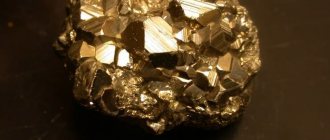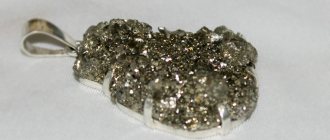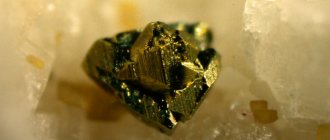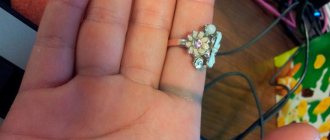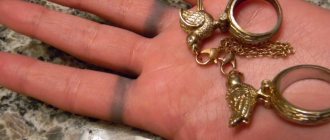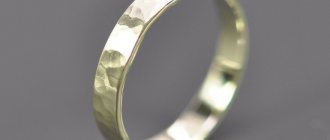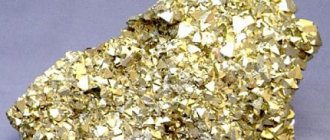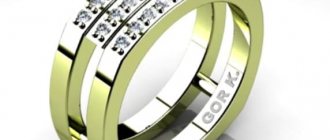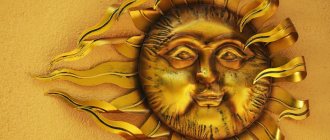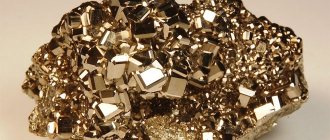The stone pyrite, or as it is also called, “fool’s gold,” is now quite famous. It was discovered back in Ancient Egypt, and it is still popular. Pyrite is a mineral that closely resembles gold in appearance, usually golden yellow in color, but this is only in appearance. The stone itself is very hard, much harder than gold itself. Crystals of this are usually found in the form of a cube, sometimes in an octagonal shape.
Fool's gold mineral pyrite - the beginning of a legend
Pyrite was often confused with gold, due to its great similarity in color, and also because this mineral was usually found next to gold. Pyrite deposits were discovered by the Indians, not far from the gold veins. When the famous “Gold Rush” began, many gold miners brought home pyrite under the guise of gold.
The peak of fashion for pyrite was in the seventeenth century in Europe. This stone was used to imitate diamonds and was inserted into jewelry made of gold and silver. It was also popular during the Napoleonic War. Products made from this stone were given to ladies who donated their precious jewelry to the needs of the war. Women liked such jewelry, but with the end of the war the fashion stopped.
Well, with the beginning of the twentieth century, inserts began to be made from raw pyrite along with other precious stones. Due to its low cost and bright appearance, this mineral is still widely used today.
Geography stories
Columbus, during his first expedition in search of water supplies, came across a certain Yaqui River. Either the Indians laughed at the admiral’s ignorance, or he himself stumbled upon “gold” placers.
He discovered that “the sand at the mouth of the river ... contains a lot of gold, although small, and suggested that the gold grains were crushed along the way from the headwaters to the mouth, and that upstream ... pieces of gold the size of lentils would be found. But there was a huge amount of small gold here.”
The admiral understood little about mineralogy and mistook pyrite placers for gold.
The pyrite gold of the Incas caused pyrite to be contemptuously called “fool’s gold.” They, of course, in this case were the Spaniards.
XVI century, rampant piracy and privateering in the West Indies. Famous pirate captains - Drake, Morgan, Kidd - and stories about disappeared treasures of gold. Treasures of gold buried by pirates could disappear. The pirates were brave guys, but for the most part they were uneducated. They could not distinguish silver from platinum and gold from pyrite. It looks like gold, which means it is. That’s why they buried pyrite instead of gold, but over time it simply turned into goethite or limonite. Real gold, of course, never disappeared.
During the Gold Rush (Alaska), gold was also confused with a mineral similar to it. Jack London wrote about this.
Shiny, golden stones were not ignored by jewelers.
While Napoleon was at war, patriotic women donated their jewelry “for victory” and in return received jewelry made from “fool’s gold.”
Your name, mineral!
The mineral received its current name from the Greek language. "Pyrites lithos" - fire stone. By hitting a piece of pyrite with metal or silicon, you will get a shower of sparks. By the way, for many centuries, pyrite worked for the benefit of people - it helped make fire. Pyrite was used as a lighter or matches.
Pyrite had other names. At different times his names were:
- health stone;
- alpine diamond;
- Inca stone;
- fools' gold;
- cat gold;
- sulfur pyrite;
- iron pyrite.
- In English, pyrite is fool's gold.
For mineral lovers: cat gold is also called one of the varieties of biotite - bauerite. The bronze-colored flakes of this mica can easily be mistaken for gold. Although it’s easy to check - a flake of gold will crumple under pressure, bauerite will break and crumble.
We recommend: MERGEL - breadwinner, builder
Large pyrite deposits
Mining pyrite is a fairly inexpensive business, since it is located next to other, usually more valuable metals, and there is no need to mine it separately. Pyrite deposits are located all over the world, but the largest are in Russia, the USA, and Sweden. It is also mined in Azerbaijan, Spain, and Norway. But the most interesting and valuable samples are supplied only by Italy.
Firestone deposits
Iron disulfide is widespread in the earth's interior, and among sulfides it ranks first.
This is one of the main ores for the production of cobalt, gold, thallium, and selenium.
But, of course, we are interested in whether it is possible to make jewelry from fire stone. Can. But not all, not any. But collectible druses and pyrite crystals are in demand among mineral lovers.
Firestone is mined in many places on the planet. This:
- Afghanistan;
- Kazakhstan;
- Spain;
- Finland;
- Mexico;
- Poland;
- USA;
- China. The list goes on...
Large Russian pyrite deposits:
- Irkutsk region;
- Karachay-Cherkessia;
- Moscow region;
- Karelia;
- Krasnoyarsk region;
- Primorsky Krai. It’s difficult to list everything.
You can find crystalline collectible pyrite in the Urals. Interesting samples are brought from Peru, Azerbaijan, Congo, Austria, and Italy.
The mineral often forms pseudomorphs from petrified wood, ammonites, and other organic remains. Such specimens would be the pride of collectors if they were kept for a long time. But alpine diamond decomposes in air, and this process cannot be stopped, only slowed down. To do this, it is boiled in paraffin, in rosin, soaked in vegetable oil, varnished... Storage in a vacuum display case is not cheap.
Physico-chemical properties of pyrite
The chemical formula of pyrite is FeS2. The stone is opaque, it has a beautiful metallic luster, and a bright golden yellow color. According to the Mohs scale, the hardness of this mineral is 6-6.5, and the density is 5.0-5.25 g/cm3. The cleavage of pyrite (i.e., the ability of the mineral to split and during this splitting to obtain smooth surfaces) is not ideal, the fracture is uneven. This mineral is also a poor conductor of electricity.
Hydrochloric acid has no effect on it, but it dissolves in nitric acid. Pyrite must be kept away from water, because of it it can quickly rust, and if it is kept in water for several years, it will completely crumble. This mineral is almost non-magnetic. Sometimes it contains impurities of gold, selenium, silver, cobalt, zinc, copper, and arsenic. Very often you come across samples of golden, dark yellow, and light golden color. The difference in color is due to impurities of other minerals: copper, nickel, gold, cobalt.
Common Varieties of Fool's Gold
Some of the most common varieties of pyrite are bravoite, chalcopyrite and marcasite.
- Bravoite - it contains a small proportion of nickel, which is why it has a pale golden color and a beautiful shiny surface. Bravoite also has a metallic sheen and sharp edges of regular shape. Due to the fact that the nickel content in bravoite reaches up to 20%, it is considered to be nickel ore.
- Chalcopyrite - also called copper pyrite, has a large proportion of copper in its composition. Its color is already brighter, sometimes even more reddish. It is not very common in industry as it is very fragile.
- Marcasite (or rainbow mineral) – it contains cobalt, thallium, and lead. Although it is fragile and short-lived, this mineral is highly prized by jewelers. Unlike pyrite, marcasite does not form large crystals; it appears as finely crystalline masses. The color of marcasite is very beautiful, iridescent. Due to its special structure, this mineral can be cast in all sorts of, almost any colors.
Healing properties of pyrite
It has long been believed that pyrite has a beneficial, healing effect on humans. Due to the strong energy that this mineral has, it can favorably influence the human biofield. Pyrite is even used to make talismans and amulets that help in the fight against depression and depression. It is especially recommended for: those who suffer from insomnia, pregnant and nursing mothers, people with venous diseases and problems with the circulatory system, those with weakened immunity, asthmatics, and for the prevention of colds.
With constant contact of pyrite with the skin, self-confidence and fortitude appear, it strengthens in making important decisions, relieves the mind of obsessive and dark thoughts, and restores calm and clarity of mind.
What kind of mineral is this
This stone is actually found where gold-bearing veins pass. Fool's gold is one of the most commonly found sulfides. It forms regular cubic crystals; strokes-faces with parallel edges are clearly visible on the faces of the mineral.
When freshly chipped, "fool's gold" has a brass-yellow or golden color, which darkens to dark yellow when exposed to oxygen in the air. The metallic luster stunned mineralogists, who argued for a long time about the nature of sulfur pyrites: some classified it as a metal, others as a mineral.
History and origin
Literally from ancient Greek the name can be translated as “stone that strikes fire.” I wonder why it's called that? The mineral has been known to mankind for a long time; along with silicon, it was valued for its ability to produce fire (it produces sparks when struck).
Archaeologists have found polished mirrors made from “fool’s gold” in Incan burials. Napoleon Bonaparte introduced an order made from this beautiful mineral: it was awarded to women who donated their jewelry to the needs of the army.
However, “fool’s gold” did not catch on as a jewelry material. This is due to the oxide film, which quickly forms on the surface of the mineral and conceals its shine. In addition, pyrite is fragile and should be protected from shock and mechanical stress.
Place of Birth
It is found everywhere both on the surface and under water. I will list the large deposits of “fool’s gold”:
- Spain (Rio Tinto, Logrono);
- USA (mines of Virginia);
- Russia (in the Urals, near Irkutsk, Altai, near Tula, in the Black Sea);
- Kazakhstan;
- Germany;
- Cyprus;
- Japan;
- Norway;
- Canada.
Beautiful large crystals are found when mining quartz veins. The mineral often accompanies hot springs, gold-bearing rock or sulfur deposits. In addition, "fool's gold" is a by-product from the smelting of copper, zinc or nickel.
Physical and chemical properties
The chemical formula of the stone is FeS2. The mineral is opaque, has a metallic luster and golden yellow color. According to the Mohs scale, “fool’s gold” is assigned a hardness value of 6–6.5 and a density of 5.0–5.2 g/cm3. The cleavage of the mineral is imperfect, the fracture is uneven. Stone does not conduct electricity well.
Hydrochloric acid has no effect on it, but it dissolves in nitric acid, albeit weakly. When exposed to water, it rusts and after several years of exposure to liquid it crumbles. Doesn't magnetize well. In sedimentary rocks, "fool's gold" can replace organic tissue.
The mineral contains impurities:
- gold;
- silver;
- zinc;
- cobalt;
- vanadium;
- copper;
- selenium;
- arsenic.
The melting point reaches 1188 °C.
Color and varieties
The color of the mineral is light yellow or golden, with a pronounced metallic luster. People who are little familiar with the properties of natural minerals may find it difficult to believe that perfectly smooth, cubic-shaped crystals with a golden luster were created by nature, and not by human hands.
There are varieties of "fool's gold" that, due to their color characteristics, are very highly prized by collectors and jewelers. For example, rainbow pyrite. Its crystals, especially large ones, are extremely rare and are very expensive for non-precious stones.
How to distinguish the original from a fake and other stones
The mineral has two close relatives with similar characteristics - marcasite and bravoite. They differ slightly from “fool’s gold” in composition and crystal lattice structure.
Sulfur pyrites are often replaced with marcasite in jewelry. It is impossible to identify such a replacement by eye, but often it is not necessary. Since the stones have a related composition, their properties are almost identical.
But you need to be able to recognize plastic passed off as pyrite. To find out whether it is a mineral or not, you need to examine the stone against the light at dusk. True pyrite is opaque. Another way to identify a fake is to scratch the mineral. Real "fool's gold" is quite hard and cannot be damaged by fingernails. But it will be quite possible to scratch paint spray from plastic.
The more important question is how to distinguish gold from a mineral. There are several popular ways to do this:
- Bite a piece with your teeth. Precious metal is soft, teeth will leave marks on it, but “fool’s gold,” like any stone, cannot be easily composted.
- Household vandalism. Pyrite can easily leave scratches on varnished surfaces or glass. Gold cannot do such a trick.
- It is not economically profitable to make a filigree product from the mineral. Therefore, openwork earrings or necklaces are most likely truly metal. At least not from pyrite.
Medicinal properties
Since ancient times, “fool’s gold” has been credited with a strong healing effect. The fact is that the mineral has a very strong energy of its own, and it is capable of influencing the human biofield. Pyrite is used to make talismans and amulets that relieve depression.
The mineral restores fortitude, strengthens one in making serious decisions, and cleanses the mind of obsessive dark thoughts. Helps counteract induced conditions and neuroses.
Pyrite is recommended for wearing:
- people suffering from insomnia;
- men with sexual dysfunction;
- women in labor and nursing mothers;
- patients with heart disorders;
- people with problems of the circulatory system and changes in the elasticity of veins and arteries;
- patients with asthma;
- in case of dysfunction of the immune system;
- for the prevention of influenza and ARVI.
Contact of the mineral with open skin will give you self-confidence, peace, and restore calm, clarity of mind and consciousness.
Magical influence
The mineral is highly valued among esotericists. None of them would call pyrite “fool’s gold”, since the stone increases concentration, strengthens the owner’s energy field and helps restore strength after magical influences and rituals.
Pyrite is credited with the ability to strengthen the love bonds that bind partners. The mineral does not tolerate inconstancy and frivolity. It helps in finding a true couple, gives patience and perseverance in overcoming family difficulties. Helps bring romance back into fading relationships.
In addition, sulfur pyrite helps to gain financial stability. It attracts finances and helps the owner in making the right investment decisions. The mineral favors entrepreneurs and people with a strong economic streak.
Only strong-willed people can withstand constant contact with the mineral. For people who do not have an iron temper, it is better to wear jewelry with pyrite several times a week, alternating with other suitable amulets.
It is not recommended to wear the mineral for people with explosive energy and temperament. Unfortunately, the fiery nature of the stone can enhance these traits, and the owner of the talisman will turn from energetic to “going ahead”, from cheerful to irritable.
Pyrite will definitely become “fool’s gold” for hypocritical people, capable of betrayal and deception. The mineral will remain indifferent to them.
There are known cases when sulfur pyrite harmed the owner, degenerating into a dark cursed amulet.
Caring for products made from material
The mineral is very fragile. A mechanical impact, such as an awkward blow, can significantly damage a figurine or an insert in a ring or bracelet.
What else should “fool’s gold” be protected from:
- long heating;
- contact with water;
- exposure to household chemicals, aggressive environments;
- contact with other stones and jewelry (for jewelry with “fool’s gold” you will have to purchase a separate box);
- direct sunlight.
To extend its life, owners of jewelry with minerals advise soaking the stone in vegetable oil or covering it with colorless varnish (nail polish is fine, but it needs to be renewed periodically).
Without coating, “fool’s gold” will lose its spectacular appearance within a few years.
What stones does it go with?
Conflict-free neighbors of a fiery mineral will be stones of the same fiery element: hematite or serpentine. It suppresses other minerals.
If the energy characteristics and compatibility of stones do not matter, then you can safely choose jewelry with a combination of “fool’s gold” and pearls or turquoise.
What names is it suitable for?
Pyrite is best combined with characteristic names; it is able to highlight the best aspects of the name’s characteristics and enhance them.
The mineral is suitable for women with names:
- Alena, Anna, Angelina, Anastasia;
- Daria;
- Eva, Elizaveta, Ekaterina;
- Hope;
- Olga, Olesya;
- Ulyana.
Pyrite is suitable for men with names:
- Artem, Arthur, Arseny, Andrey, Anton;
- Denis;
- Evgeny, Egor;
- Michael;
- Oleg;
- Novel;
- Sergey, Stepan.
Who is pyrite suitable for according to their zodiac sign?
The mineral favors sunny summer signs: Gemini, Cancer, Leo and Virgo. Sulfur pyrite will help them realize their inner potential and discover opportunities, find a couple.
For Aries Leo and Sagittarius, pyrite will become a talisman of firmness and self-confidence.
“Fool’s gold” will not suit representatives of water signs (except Cancers).
Magic properties
Practicing sorcerers and magicians claim that the stone is able to restore their energy after various magical rituals, and that in those who achieved harmony with pyrite, it awakened a desire for the high, spiritual. Such owners gained the ability for self-development, as he saved them from laziness, anxiety and doubt.
It is also believed that pyrite attracts cash flows and makes it easier to find new ways to make money, or even start your own business. Pyrite also has a beneficial effect on family relationships. He is able to bring romance back into relationships and help in family matters. Products made from pyrite protect the house from enemies and save the owner from danger.
But this stone will faithfully serve and help only people with pure thoughts. Pyrite does not like evil, vile and hypocritical people; it can begin to “harm” such people, and instead of having healing properties, it will act negatively.
Who is pyrite best suited for?
Jewelry made from pyrite can be worn by almost everyone. It will have a good effect on the entire body. A man who wears pyrite products becomes confident in himself, and women begin to be attracted to him. But this stone is for those who like serious long-term relationships, and not for lovers of short-term hobbies. It’s also much easier for girls to find their man with the help of pyrite.
Plot
Ben Finnegan, nicknamed Finn, devoted the last eight years of his life to searching for the sunken Spanish galleon Aurelia with the gold of the Spanish crown on board. And at the very moment when he found a clue - a fragment of a plate with the symbols of the galleon captain - everything goes awry. The boat with all the equipment sinks, the main sponsor Big Bunny loses patience and not only deprives him of funding, but also tries to drown Finn, his beloved wife Tess divorces him.
At this time, millionaire Nigel Honeycutt's daughter Gemma arrives to stay on his yacht. Finn decides that with the help of his daughter he will get to his father and he will finance his enterprise. Having effectively caught Gemma's flying hat, Finn finds himself on a yacht. Here he meets his ex-wife, who works on the ship. Finn and Tess, who was formerly Finn's companion and the brains behind the treasure hunt, tell Nigel and Gemma directly about the sunken galleon and they agree to join the search.
But Big Bunny, having parted with Finn, did not give up his desire to find the treasure. He finds a new executor, Moe Fitch, Finn's old mentor in the search for underwater treasures. It is not surprising that the paths of competing firms cross, threatening Finn and Tess with new troubles. Tess and Finn's search leads them to an old church on an island where a treasure ship was moored. In the church archives they find a mention of a grave with the name of the ship “Aurelia”, and at the same time restore broken relationships. Having excavated the grave, they find a ship's log with a comprehensive description of where the treasure is hidden - in a flooded cave on this island. To get to the Spanish riches, there is one last obstacle to overcome - Big Bunny and a couple of thugs who suddenly appeared in front of the main characters.
Thanks to the agility and courage of the Finnegan couple, the help of the Honeycutt family and Mo Fitch, who has gone over to the side of good, the treasures of the Spanish crown fall into good hands.
The influence of pyrite on zodiac signs
Aries from envy and deception, improve things at work, and generally influence life in a positive way, making it more pleasant and brighter. It will help you overcome failures and begin to strive for self-improvement.
For Leos, the stone will help improve family life and renew passion between spouses. The Leo man will receive a boost of energy, and the woman will feel beautiful and desirable again.
For Sagittarius, the stone will help them find spiritual harmony, understand themselves, and find their right path in life.
For Taurus , the mineral will help channel their violent energy in the right direction, gain financial stability, and improve relationships with people. It will also help in finding your other half.
For Gemini, the stone will help them become more reasonable, increase their concentration, and be more collected.
Cancers are not recommended to wear items made of pyrite, since the stone conflicts with water signs and the energy of the stone is not suitable for them.
Fish . For men, pyrite will be magically useless, but for girls it will help them find a husband, find family happiness, and become more collected.
For Aquarius, the stone will be useless, but it will not do any harm.
for Virgos to wear pyrite all the time. It's better to just keep it at home, taking it out only occasionally.
For Capricorns, the mineral will help improve their financial and personal situation and unlock their potential.
Scorpio will be protected from damage and evil.
Libra is recommended to wear pyrite as an amulet constantly. He will protect them from rash decisions and protect them from danger.
Firestone magic
The Spartans (and they were raised for war) were confident in the magical power of pyrite amulets. They bestowed boundless courage, courage in battle, and protected from betrayal.
The magical properties of pyrite were previously used by alchemists. Now the magic of the Alpine diamond is held in high esteem by modern magicians and sorcerers.
But the stone will also help ordinary people become more self-confident and reveal leadership qualities. Your mood is at zero, you shy away from work - pyrite will help. It will lift your spirits, invigorate you and give you vitality. That's what esotericists say, in any case.
Pendant with pyrite
Nowadays, the pyrite talisman is a good talisman for firefighters and military personnel, emergency workers, and police officers.
Information for men: pyrite will provide you with victories on the love front.
The mineral is solitary by nature and cannot stand the proximity of other stones. Compatibility with other stones in jewelry (from the point of view of magical properties) is out of the question. The exception is serpentine and hematite.
A gold-like mineral attracts money to the home and to the owner of the jewelry.
Just don’t wear the jewelry for more than 3-5 days in a row - the powerful magic of the fire stone can harm a person.
Use of pyrite in industry
In industry, this mineral has received very wide application; it is used in a variety of fields. Sulfuric acid is obtained from it, pyrite cinders can be used as iron ore, added to concrete, chemical waste is purified from chlorine impurities, and sometimes gold, nickel, chromium, cobalt, silver, and copper are extracted from it.
Jewelers make a variety of jewelry from it. This stone is inserted into gold and silver, sometimes even in its raw form. And large rainbow pyrite stones with regular geometric shapes have real value for collectors and can be quite expensive.
Application: from cast iron to figurines
The importance of pyrite for industry (and therefore for our comfortable life) is great.
- For many years, the production of sulfuric acid was impossible without firestone.
- Pyrite consists of two elements - iron and sulfur. So they get iron and cast iron from it, Alpine diamond.
- Sulfur was also previously extracted from firestone. Nowadays it is mainly obtained as a by-product of oil and gas refining (a headache for oil workers is sulfurous oil).
- Sulfuric acid is also easy to obtain from pyrite by reacting it with oxygen.
- Oxidative roasting of iron disulfide - and you get iron sulfate. If you don’t know what it is, it means you’re not a summer resident, not a gardener, and you haven’t had iron deficiency anemia.
- Jewelers are trying to use the shine and resemblance to gold of this mineral.
We recommend: The meaning and properties of QUARTZ DRUZ
They tried to make watch cases, trinkets, umbrella handles, boxes, and figurines from “clown gold.” However, the capricious mineral in a humid climate quickly rusted, darkened, and lost its marketable appearance.
That’s when museum curators came up with the idea of boiling items made from “Inca gold” in paraffin or covering them with colorless varnish—the jewelry became safe to wear.
How to recognize a fake
Yes, despite its cheapness, “fool’s gold” is also counterfeited. And in the simplest way, ordinary paint is applied to plastic or glass. It is quite easy to recognize whether it is a fake or not. Look carefully at the light, pyrite is always opaque, or run your fingernail over the product, if a scratch is formed, it means that it is spraying, and you are being deceived.
It is also not difficult to distinguish pyrite from gold. Gold is softer and more pliable, has a streamlined shape, while pyrite, on the contrary, is hard, has sharp edges, and in appearance it is more like a crystal. Also, gold, unlike pyrite, does not enter into chemical reactions with most substances. And the shine of gold in the light is completely different from that of false gold, which loses its shine in the light.
Care and storage of pyrite products
It is advisable to store jewelry in some dark place, avoiding the proximity of other stones. It is quite fragile and it is necessary to protect it as much as possible from impacts and falls. Do not allow water to enter; it is recommended to clean pyrite jewelry with a regular dry cloth. Pyrite should be stored separately from other stones; it can only tolerate the proximity of serpentine and azurite.
If you liked the article, share it on social networks, it’s important to us
Tags:fool's gold mineral
